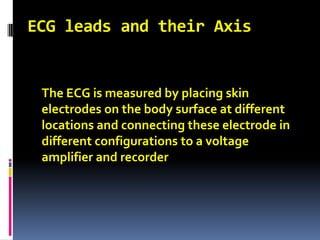
53
- 1. ECG leads and their Axis The ECG is measured by placing skin electrodes on the body surface at different locations and connecting these electrode in different configurations to a voltage amplifier and recorder
- 3. 3 Augmented leads (aVR, aVL, aVF)
- 5. To record limb lead I, the negative terminal of the electrocardiograph is connected to the right arm and the positive terminal to the left arm To record limb lead II, thenegative terminal of the electrocardiograph is connected to the right armand the positive terminal to the left leg To record limb lead III, the negative terminal of the electrocardiograph is connected to the left armand the positive terminal to the left leg
- 6. Normal Electrocardiograms Recorded from the Three Standard Bipolar Limb Leads Recordings of the electrocardiograms in leads I, II, and III. It is obvious that the electrocardiograms in these three leads are similar to one another because they all record positive P waves and positive T waves, and the major portion of the QRS complex is also positive in each electrocardiogram
- 7. Because the recordings from all the bipolar limb leads are similar to one another, it does not matter greatly which lead is recorded when one wants to diagnose different cardiac arrhythmias, because diagnosis of arrhythmias depends mainly on the time relations between the different waves of the cardiac cycle. But when one wants to diagnose damage in the ventricular or atrial muscle or in the Purkinje conducting system, it does matter greatly which leads are recorded, because abnormalities of cardiac muscle contraction or cardiac impulse conduction do change the patterns of the electrocardiograms markedly in some leads yet may not affect other leads.
- 8. Chest Leads (Precordial Leads) Each of the 6 precordial leads is unipolar (1 electrode constitutes a lead) and is designed to view the electrical activity of the heart in the horizontal Usually six standard chest leads are recorded, one at a time, from the anterior chest wall, the chest electrode being placed sequentially at the six points shown in the diagram. The different recordings are known as leads V1, V2, V3, V4, V5, and V6.
- 9. Chest Leads (Precordial Leads) V1 - 4th intercostal space - right margin of sternum V2 - 4th intercostal space - left margin of sternum V3 - linear midpoint between V2 and V4 V4 - 5th intercostal space at the mid clavicular line V5 - horizontally adjacent to V4 at anterior axillary line V6 - horizontally adjacent to V5 at mid-axillary line
- 10. Chest Leads (Precordial Leads) In leads V1 and V2, the QRS recordings of the normal heart are mainly negative because,, the chest electrode in these leads is nearer to the base of the heart than to the apex, and the base of the heart is the direction of electronegativity during most of the ventricular depolarization process. Conversely, the QRS complexes in leads V4, V5, and V6 are mainly positive because the chest electrode in these leads is nearer the heart apex, which is the direction of electropositivity during most of depolarization
- 11. Augmented Unipolar Limb Leads In this type of recording, two of the limbs are connected through electrical resistances to the negative terminal of the electrocardiograph, and the third limb is connected to the positive terminal. When the positive terminal is on the right arm, the lead is known as the aVR lead when on the left arm, the aVL lead and when on the left leg, the aVF lead
- 12. They are all similar to the standard limb lead recordings, except that the recording from the aVR lead is inverted
- 13. EKG with a Normal Axis
- 14. Views of the Heart Some leads get a good view of the: Lateral portion of the heart (I,AVF,V5, V6) Anterior portion of the heart (V1-V4) Inferior portion of the heart (II,III AVF)
- 15. That the 12-leads of the ECG look at different portions of the heart. The limb and augmented leads “see” electrical activity moving inferiorly (II, III and aVF), to the left (I, aVL) and to the right (aVR). Whereas, the precordial leads “see” electrical activity in the posterior to anterior direction Limb Leads Augmented Leads Precordial Leads
- 16. Current Flow & Lead Axis If the electrical current from the heart is moving towardan electrode placed on the chest, the EKG complex will be positive(upward deflection) If the electrical current of the heart is moving awayfrom the electrode, the EKG complex will be negative (downward deflection) The sum of all the electrical activities of the heart is consistent with the electrical activity of the left ventricle and is therefore directed downwardand to theleft of the body, approximately at 60°
